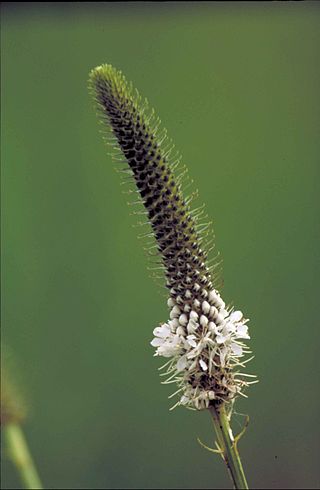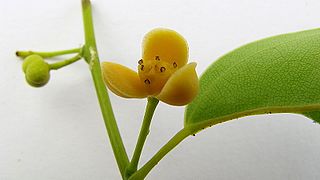
Mimosa is a genus of about 600 species of herbs and shrubs, in the mimosoid clade of the legume family Fabaceae. Species are native to the Americas, from North Dakota to northern Argentina, and to eastern Africa as well as the Indian subcontinent and Indochina. The generic name is derived from the Greek word μῖμος (mimos), an "actor" or "mime", and the feminine suffix -osa, "resembling", suggesting its 'sensitive leaves' which seem to 'mimic conscious life'.

Erythrina is a genus of plants in the pea family, Fabaceae. It contains about 130 species, which are distributed in tropical and subtropical regions worldwide. They are trees, with the larger species growing up to 30 m (98 ft) in height. The generic name is derived from the Greek word ερυθρóς erythros, meaning "red", referring to the flower color of certain species.

Cassia is a genus of flowering plants in the legume family, Fabaceae, and the subfamily Caesalpinioideae. Species are known commonly as cassias. The genus includes 37 species and has a pantropical distribution. Species of the genera Senna and Chamaecrista were previously included in Cassia. Cassia now generally includes the largest species of the legume subtribe Cassiinae, usually mid-sized to tall trees.

Calliandra is a genus of flowering plants in the pea family, Fabaceae, in the mimosoid clade of the subfamily Caesalpinioideae. It contains about 140 species that are native to tropical and subtropical regions of the Americas.

Menispermaceae is a family of flowering plants. The alkaloid tubocurarine, a neuromuscular blocker and the active ingredient in the 'tube curare' form of the dart poison curare, is derived from the South American liana Chondrodendron tomentosum. Several other South American genera belonging to the family have been used to prepare the 'pot' and 'calabash' forms of curare. The family contains 78 genera with some 440 species, which are distributed throughout low-lying tropical areas with some species present in temperate and arid regions.

Abuta is a genus in the flowering plant family Menispermaceae, of about 32 species, native to tropical Central and South America.

Senna, the sennas, is a large genus of flowering plants in the legume family. This diverse genus is native throughout the tropics, with a small number of species in temperate regions. The number of species is estimated to be from about 260 to 350. The type species for the genus is Senna alexandrina. About 50 species of Senna are known in cultivation.
Abuta candicans is a species in the family Menispermaceae.

Dalea is a genus of flowering plants in the legume family, Fabaceae. Members of the genus are commonly known as prairie clover or indigo bush. Its name honors English apothecary Samuel Dale (1659–1739). They are native to the Western hemisphere, where they are distributed from Canada to Argentina. Nearly half of the known species are endemic to Mexico. Two species of Dalea have been considered for rangeland restoration.

Chamaecrista is a genus of flowering plants in the pea family, Fabaceae, subfamily Caesalpinioideae. Members of the genus are commonly known as sensitive pea. Several species are capable of rapid plant movement. Unlike the related genera Cassia and Senna, members of Chamaecrista form root nodules.
Rupert Charles Barneby was a British-born self-taught botanist whose primary specialty was the Fabaceae (Leguminosae), the pea family, but he also worked on Menispermaceae and numerous other groups. He was employed by the New York Botanical Garden from the 1950s until shortly before his death.

Psorothamnus is a genus of plants in the legume family. These are shrubs and small trees. Many are known by the general common name indigo bush. Some are referred to as daleas, as this genus was once included in genus Dalea. These are generally thorny, thickly branched, strongly scented bushes. Most species bear lupinlike raceme inflorescences of bright purple legume flowers and gland-rich pods. Psorothamnus species are native to the southwestern United States and northern Mexico. The genus is paraphyletic and it has been proposed that the genus Psorodendron be reinstated to accommodate sections Xylodalea, Capnodendron, and Winnemucca.

Astragalus lentiginosus is a species of legume native to western North America where it grows in a range of habitats. Common names include spotted locoweed and freckled milkvetch. There are a great number of wild varieties. The flower and the fruit of an individual plant are generally needed to identify the specific variety.

Erythrina flabelliformis, common name chilicote or western coral bean, is a plant species native to central and northwestern Mexico and the southwestern United States. It is known from Baja California as far south as Morelos and as far east as San Luis Potosí, as well as from Arizona and New Mexico.
Curarea is a genus of flowering plants in the family Menispermaceae, found in tropical parts of Central and South America. They are dioecious lianas, with at least some species producing toxic compounds such as curare.
Telitoxicum is a genus of flowering plants belonging to the family Menispermaceae.
Caryomene is a genus of flowering plants belonging to the family Menispermaceae.

Orthomene is a genus of flowering plants belonging to the family Menispermaceae.
Sciadotenia is a genus of flowering plants belonging to the family Menispermaceae.

Elephantomene is a monotypic genus of flowering plants belonging to the family Menispermaceae. The only species is Elephantomene eburnea.














